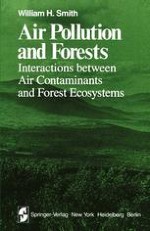1981 | OriginalPaper | Buchkapitel
Class I Summary: Relative Importance of Forest Source and Sink Strength and Some Potential Consequences of These Functions
verfasst von : William H. Smith
Erschienen in: Air Pollution and Forests
Verlag: Springer US
Enthalten in: Professional Book Archive
Aktivieren Sie unsere intelligente Suche, um passende Fachinhalte oder Patente zu finden.
Wählen Sie Textabschnitte aus um mit Künstlicher Intelligenz passenden Patente zu finden. powered by
Markieren Sie Textabschnitte, um KI-gestützt weitere passende Inhalte zu finden. powered by
The Class I relationship between forest ecosystems and air pollution is of primary importance when the atmospheric load of air contaminants from anthropogenic sources is relatively low. This situation exists locally and regionally when the sources of air pollutants produced by the activities of human beings are not operating or operating at low level or when meteorological conditions are not conducive to atmospheric accumulation. On a global scale, the Class I relationship may be extensive throughout those regions relatively remote from the activities of people. The specific concentration of air contaminants under “low” conditions is variable depending on the pollutant, but in general is meant to approximate “background,” clean-air concentrations as, for example, presented by Rasmussen et al. (1975) for the major trace gases in μg m-3 : sulfur dioxide (1–4), hydrogen sulfide (0.3), dinitrogen oxide (460–490), nitric oxide (0.3–2.5), nitrogen dioxide (2–2.5), ammonia (4), carbon monoxide (100), ozone (20–60), and reactive hydrocarbons (<1). Since the majority of air contaminants of greatest significance to vegetative and human health (Table 1-1) originate from, and are removed by, both anthropogenic and natural agents it is essential to evaluate the importance of forest ecosystems within the latter group.
